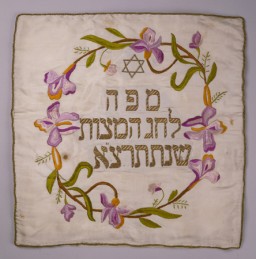<< Previous | Displaying results 1661-1670 of 6705 for "" | Next >>
-
North-China Daily News photo showing Jewish Refugees in Shanghai, China
ArtifactAn illustration in the North-China Daily News following the arrival of a group of Jewish refugees in Shanghai, in Japanese-occupied China. August 24, 1941. [From the USHMM special exhibition Flight and Rescue.]
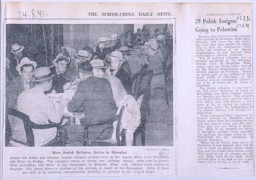
-
Tourist pamphlet about Kobe, Japan
ArtifactThe Municipal Tourist Office in Kobe issued this folded English-language tourist guide to the city. One side shows photographs and descriptions of Kobe's historic and scenic sites and the other provides a tourist map of Kobe. Jewish refugees in Kobe used such pieces of information. Kobe, Japan, 1940-1941. [From the USHMM special exhibition Flight and Rescue.]
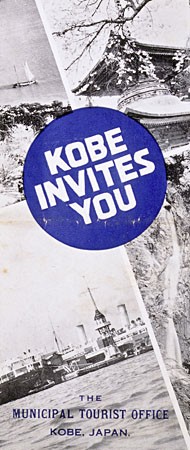
-
Illustration from tourist guide to Kobe and its environs
ArtifactThe Kobe Municipal Office issued an English-language tourist guide to Kobe and its environs. This illustration comes from the interior pages of the guide. Jewish refugees in Kobe used such pieces of information. Kobe, Japan, 1940-1941. [From the USHMM special exhibition Flight and Rescue.]
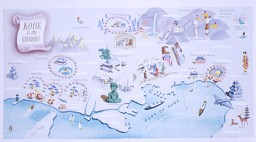
-
Cover of a Japanese-German phrase book
ArtifactGerman Jewish refugees purchased this Japanese-German phrase book shortly after their arrival in Japan. Japan, 1940-1941. [From the USHMM special exhibition Flight and Rescue.]

-
Chart of Prisoner Markings
ArtifactA chart of prisoner markings used in German concentration camps. Dachau, Germany, ca. 1938–1942. Beginning in 1937–1938, the SS created a system of marking prisoners in concentration camps. Sewn onto uniforms, the color-coded badges identified the reason for an individual’s incarceration, with some variation among camps. The Nazis used this chart illustrating prisoner markings in the Dachau concentration camp.
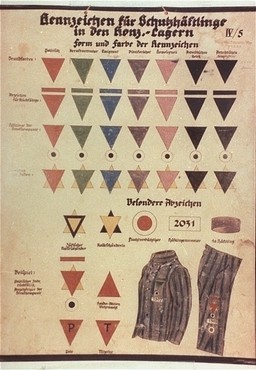
-
Railcar: Interior
ArtifactMany different kinds of railway cars were used for deportations. They varied in size and weight. The railway car on display in the United States Holocaust Memorial Museum's Permanent Exhibition is of just one type used. The dimensions of the railway car in the Museum's exhibition are as follows: Total length 31 feet 6 inches (9.6 meters); interior space for deportees 26 feet 2 inches (8 meters). Total height 14 feet (4.3 meters) from the bottom of the wheel to the highest point of the car; interior space…
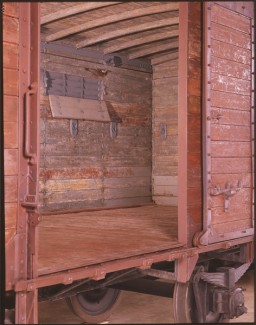
-
Valises by the railcar in the Museum's Permanent Exhibition
ArtifactMany different kinds of railway cars were used for deportations. They varied in size and weight. The railway car on display in the United States Holocaust Memorial Museum's Permanent Exhibition is of just one type used. The dimensions of the railway car in the Museum's exhibition are as follows: Total length 31 feet 6 inches (9.6 meters); interior space for deportees 26 feet 2 inches (8 meters). Total height 14 feet (4.3 meters) from the bottom of the wheel to the highest point of the car; interior space…

-
Wedding Dress
ArtifactThis wedding dress was made from a parachute and worn by Lilly Lax for her wedding to Ludwig Friedman in a displaced persons camp. Ludwig had promised to find fabric for a white gown, and purchased an old parachute for this purpose. Lilly hired a seamstress to make the dress in exchange for her cigarette ration. Other brides in the Celle and Belsen displaced persons camps subsequently wore the dress. Lilly and Ludwig immigrated to the United States in 1948.
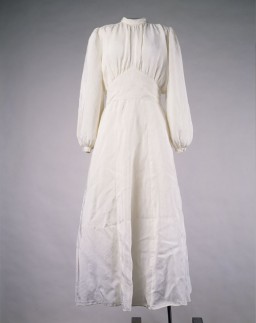
-
Wool Bedcover
ArtifactFollowing the Soviet occupation of Lithuania, the Lifszyc family began to search for ways to leave the country. David Lifszyc obtained a Curacao visa from the Dutch consulate. He also obtained an American visa because he was included on a list of distinguished rabbis submitted to the State Department by the Agudat Israel of America. After obtaining Soviet exit visas, the Lifszycs purchased tickets for Vladivostok on February 5, 1941. They started for Moscow, where they received Japanese transit visas. This…
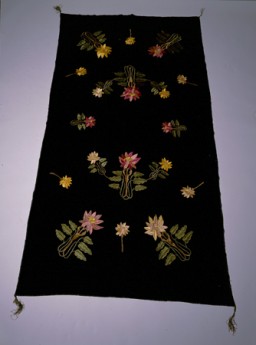
-
Embroidered matzah cover
ArtifactFollowing the Soviet occupation of Lithuania, the Lifszyc family began to search for ways to leave the country. David Lifszyc obtained a Curacao visa from the Dutch consulate. He also obtained an American visa because he was included on a list of distinguished rabbis submitted to the State Department by the Agudat Israel of America. After obtaining Soviet exit visas, the Lifszycs purchased tickets for Vladivostok on February 5, 1941. They started for Moscow, where they received Japanese transit visas. This…
